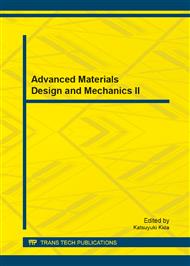p.70
p.75
p.80
p.84
p.88
p.97
p.101
p.104
p.111
Reaction Products of Lime Zeolite Stabilized Kaolin Humic Acid
Abstract:
Lime, a traditional calcium based stabilizer, had been widely used in chemical stabilization to improve the strength of soil. Past researches had shown that the major reaction product of lime and soil such as Calcium Silicate Hydrate (CSH) was formed abundantly under the observation of microscopic studies. However, sometimes it will be quite difficult to confirm the existence of CSH phase if solely based on its needle like structures, especially when other rod like structures will also exist. Practically, the recognition of the CSH phase by using XRD spectrum through matching with published data had speed up the process of identification. If the method is viable, then theoretically, the molecular weight ratio of silica and calcium, S/C of CSH gel is specific and can be determined based on its possible chemical compound. Hence, this study was carried out in an attempt to examine the possibility use of its S/C ratio as a quick method to confirm the existence of CSH gel. Two types of artificial organic soils were formed by admixing kaolin (inorganic matter) and humic acid (organic matter) with the ratio of 7:3 and 5:5. Four types of admixtures with different percentages ratio of lime and zeolite (a kind of pozzolan) were used to stabilize the soils. The specimens were cured at elevated temperature of 50°c in order to accelerate the development of reaction products. Field Emission Scanning Electron Microscope with attached Energy Dispersive Analyzer (FESEM-EDX) was utilized to observe and determine the existence of reaction products and its bulk chemical composition. The S/C ratio of needle like structures were determined and it is found that the S/C ratio fluctuates and varies significantly from one specimen to another. It is believed that due to the limitations of the experimental setup, the EDX analysis can only serve as semi-quantitative and act as a reference guide on the existence of element. Despite of its limitations, the EDX analysis is useful in distinguish the CSH from other structure which is physically un-identical.
Info:
Periodical:
Pages:
88-96
Citation:
Online since:
August 2013
Keywords:
Price:
Сopyright:
© 2013 Trans Tech Publications Ltd. All Rights Reserved
Share:
Citation:


